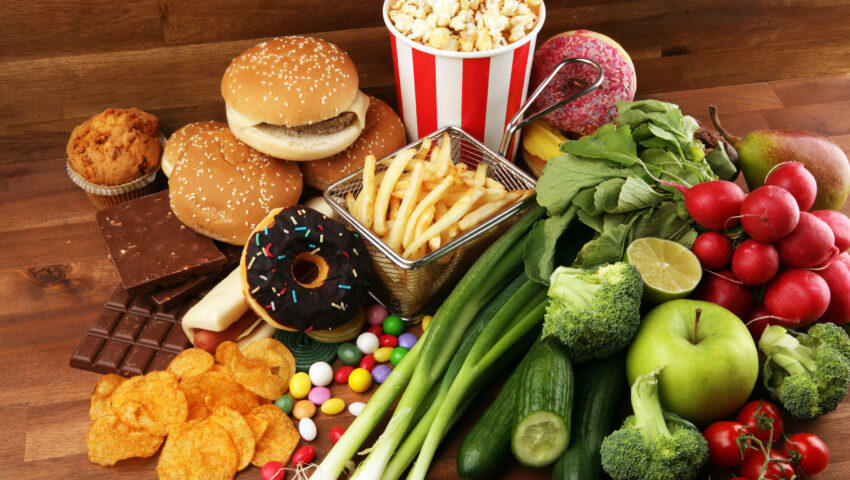Blogs
Difference between energy and nutrient density

To mark the anniversary of the calorie legislation coming into effect, in this blog we are going to discuss the difference between energy density and nutrient density.
Before we dive in, I want you to reflect on whether the calorie law has made any difference to your choices since it was introduced.
For example:
- When going out to restaurants, has seeing the kcal amounts for menu items caused you to choose a different option?
- When grabbing something for lunch whether it be at work or outside?
- Has it made you choose different options when you are doing your weekly food shop?
What is the difference between energy or nutrient-dense foods?
- Nutrient-dense foods provide us with the essential vitamins, minerals, and other nutrients we need that tend to be more filling, satisfying, and nourishing to our bodies whilst containing lower calories. For example, a serving of broccoli may be lower in calories than a serving of chips, but it’s also much higher in essential nutrients like vitamin C and potassium.
- Energy-dense foods provide a high number of calories in a small amount of food, which is generally higher in fat and sugar. While energy-dense foods can provide a quick source of energy, they often provide little to no nutritional benefits. For example, a bag of crisps may contain more energy per 100gs than a 100g serving of humous and vegetable sticks. Therefore, if we consume too many high-energy-dense foods, such as processed snacks and sugary drinks, this can add a lot of additional calories to our diet without providing many essential nutrients, increasing our risk of poor health outcomes.
It is important we don’t just concentrate on consuming the right number of calories, but instead, we should be aiming to consume a well-balanced and diverse diet that includes an array of essential nutrients.
However, sometimes this is easier said than done and we must consider that…
- Some foods can contain a similar energy density but can be hugely different in terms of the nutrients they provide. For example, a medium-sized orange and a scoop of vanilla ice cream- may have the same calories, but they have vastly different contents of added sugars, fibre, vitamins, and fats.
- And just to throw you a curve ball… some delicious foods such as nuts, seeds, oily fish, and avocado may have high energy density but are packed full of delicious nutritional benefits. However, the opposite can also be true, some low- energy-dense foods can also have no nutritional benefits such as diet soda.
Ways to include more nutrient-dense foods into our diet whilst consuming less energy-dense foods?
- Try planning your meals for the week, and make a list of nutrient-dense foods that you’ll need. This will help you make healthier choices when shopping without the pesky high-energy-dense foods randomly appearing in your basket or trolley (I’m definitely guilty of that), whilst ensuring you have a variety of nutrient-dense foods on hand.
- Cook from scratch at home- this gives you more control over the ingredients you use and can make sure to include nutrient-dense foods.
- Review the cooking methods you use, by swapping frying to grill, steaming, or baking to help retain nutrients and reduce calories in meals your meals by using oil.
- Choose whole grains over refined grains such as quinoa, brown rice, and whole wheat bread, which are more nutrient-dense than refined grains like white bread and white rice.
- Choose lean protein sources such as chicken, fish, and legumes, which are more nutrient-dense than processed meats such as bacon and sausages which can be high-fat or salt. Also, do not be afraid of healthy fats which can be found in foods such as avocado, nuts, and olive oil, provide essential nutrients, and can be included as part of a nutrient-dense diet.
- Experiment with different foods? Try to incorporate new nutrient-dense foods into meals, such as leafy greens, berries, and nuts, to add variety to your diet and ensure that you are getting a wide range of essential nutrients.
Monthly challenge:
For this month’s challenge, try to think less about the calorie content of food and the nutritional quality of the foods you are consuming instead! To help you, try and adopt one of the healthy tips I mentioned above that would easily fit into your daily/weekly routine.
Overall, it is important to base our diets on nutrient-dense foods to ensure our bodies receive the essential nutrients they need to function and thrive, as well as decrease our risk of developing certain diseases.
Further reading recommendation:
https://www.eufic.org/en/understanding-science/article/what-is-nutrient-density




